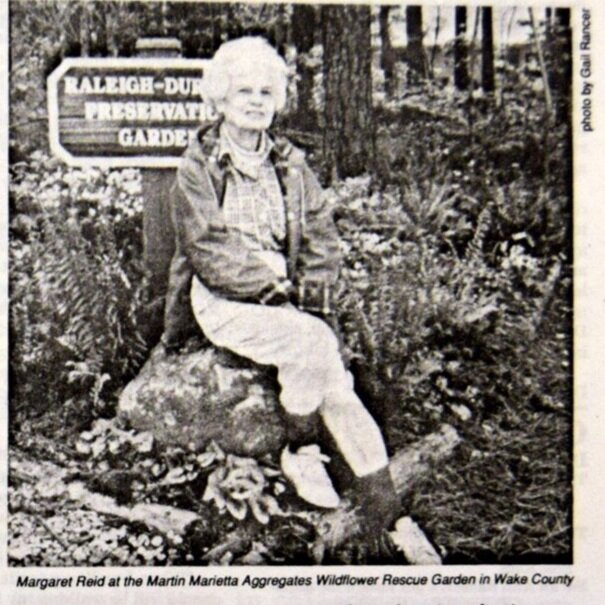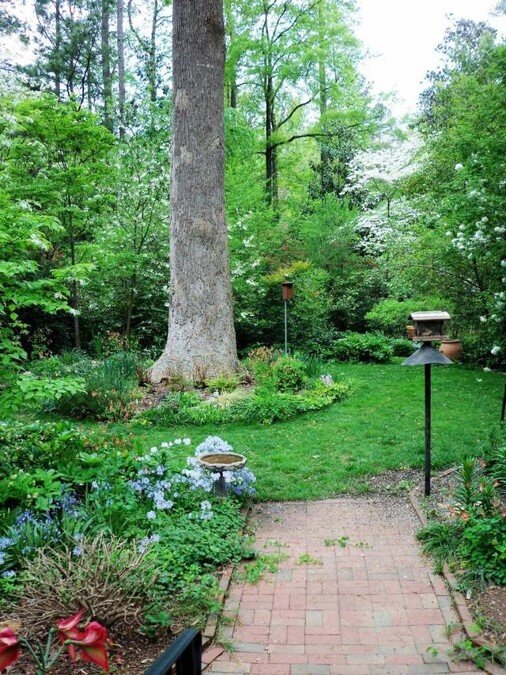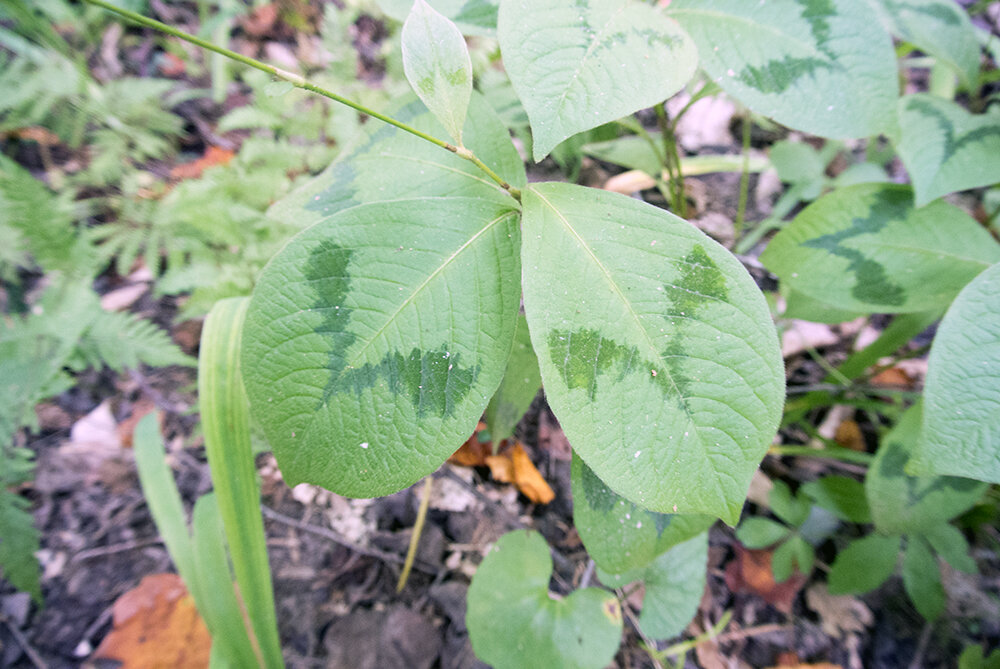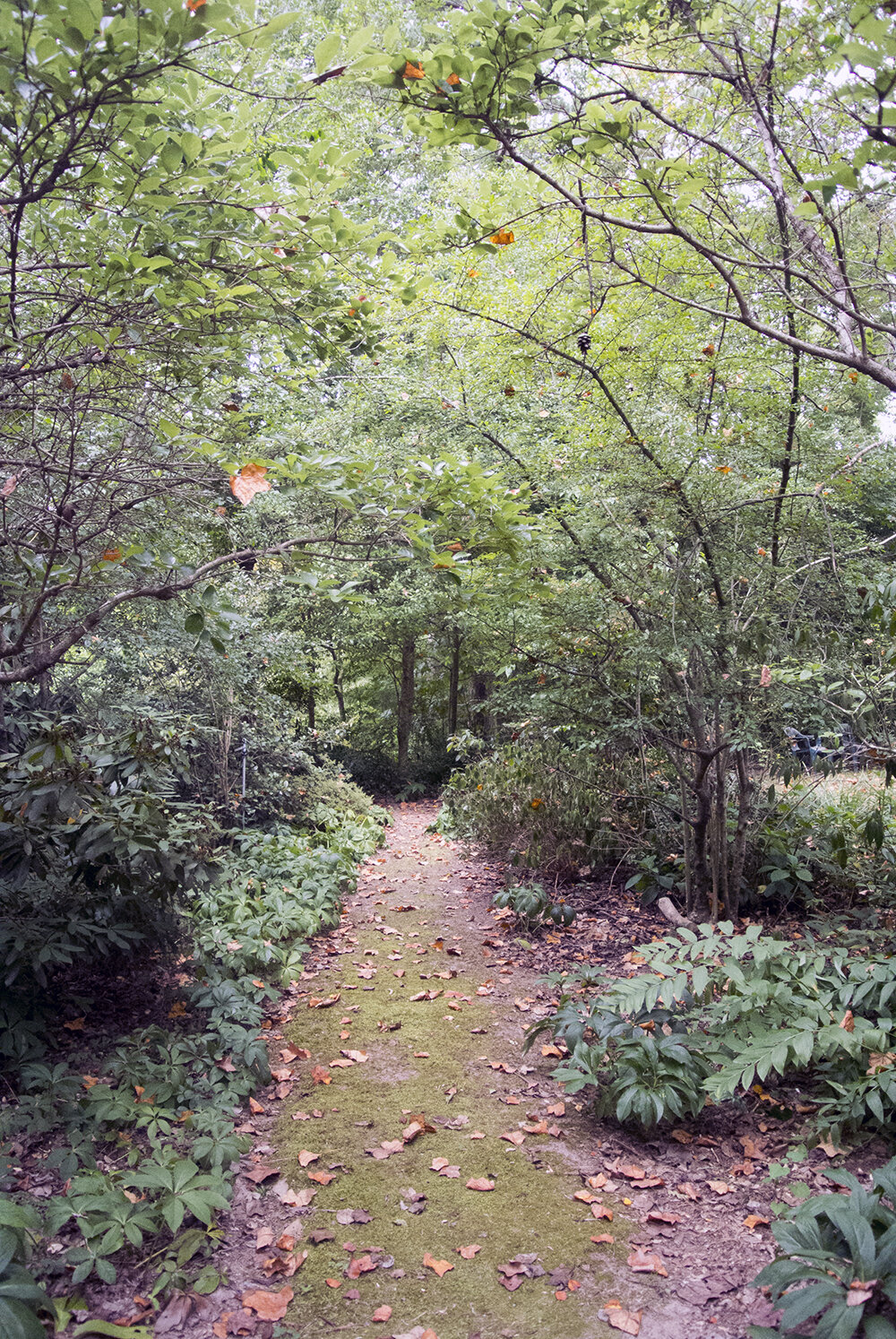by Vicki Sanders Corporon
“When I walk my trails and think a hundred years from now,” Margaret Reid told Jack Hogan of the Triangle Land Conservancy in 1992, “some people will be walking my trails, and no little girl will grow up without seeing hepatica bloom.”





Margaret Baker Reid and her NC State University (NCSU) chemistry professor husband, Alton, bought a home and 2-acre lot at 1439 Dixie Trail about 60 years ago. Today that home surrounded by so much land is considered prime real estate in downtown Raleigh, but back then Margaret’s friends thought she was essentially moving to the country. Margaret Reid would transform the surrounding property into her own personal botanical treasure chest of NC native plants, and because of Margaret’s long-term conservation strategy, you can see the garden for yourself. How did all that come about? Here’s the story of one of the Raleigh Garden Club’s early leaders.
Margaret Reid grew up in eastern Wake County and dreamed of having a garden of her own. She was quite pleased with the potential of the property she and Alton purchased. In those two acres, she would create a garden of distinction and one of importance to botanists and ecologists.
Margaret sought out the companionship of other area gardening enthusiasts and joined the Raleigh Garden Club in the 1930s. From its inception, the Raleigh Garden Club had distinguished itself for sharing garden tips for members’ home gardens, as well as sponsoring projects to beautify public spaces. Unlike some of the members who cultivated more formal gardens at their homes, Margaret had a preference for something more natural. She planned to maximize the potential of the woodland surrounding her home by filling it with North Carolina’s native plants. She didn’t find these plants in a local nursery or garden center, she found them in areas destined to be plowed over for the city’s growth.
She tells of saving her first plant in 1932 (when Herbert Hoover was president). The satisfaction of salvaging beautiful plants that were naturally adapted to our area turned into a driving force. Because her property had so many habitat options (elevation changes, dry/moist terrain, open/shaded areas) beneath her oaks, poplars and pines, she could find just the right transfer spot to enable successful transplanting of these rescues.
When she heard of the widening of Canterbury Road in Raleigh that would destroy a swath of green and gold plants, she beat the bulldozer crew there and dug up these plants. With each proposed housing development, mall, road, and business project that would transform our growing capitol city, Margaret made plans to get permission and remove endangered plants there first.
Her garden showcased blooming plant varieties before her Raleigh Garden Club friends’ late spring cultivars commanded attention — another plus. Native woodland plants take advantage of the sunlight available to them before trees get their leaves, and thus from February through April, her garden was filled with color and fragrance from blooming hepatica, wind flower, trillium, trout lily, green and gold, lady’s slipper, foamflower, golden Alexander, and goatsbeard. She would point out to visitors that some of those lady’s slippers, foamflower, and golden Alexander came from the site for Cameron Village in 1948. She salvaged trailing arbutus, hepatica and galax from the Martin Marietta Rock Quarry.
She was encouraged in this early environmental conservation movement by a colleague of her husband’s at NCSU: Dr. Bertram Whittier Wells, head of the Botany Department at the college for 30 years. She took botany and ecology classes from him and she gleaned tips from the book he wrote, entitled Natural Gardens of North Carolina. Over the years Dr. Wells became her close friend and plant mentor, and the two of them made a good plant-collecting team.
But a good deal of what she learned came from studying the native habitats of NC plants she encountered on plant rescue missions and matching those habitats as closely as possible to similar terrain in her own lot — taking note of which plants needed moist or dry habitats, which needed more sun or less. She traveled across the state and even into South Carolina on plant rescue expeditions, then transferred her rescues to her garden in groupings, or “playhouses,” mimicking natural plant communities in the wild.
Her second native-plant collecting buddy was Harry Thatcher, my North Raleigh neighbor and native-plant mentor. I recall their returning from plant rescue trips and unloading/dividing specimens in Harry’s driveway — specimens destined to be saved for posterity in their respective gardens. That’s where I first met Margaret in the 1970s. By then her hair had grayed a bit, but she had not slowed down in the least. Devoting hours a day finding, digging, transplanting, and tending plants keeps a person fit!
I was delighted to be given a tour of her garden to see how she made use of her plant rescues. After decades of nurturing, her garden had matured into a complex system of trails. Shady highbush blueberry corridors led to paths with wider vistas. Ferns contrasted with clusters of lilies with strap-like leaves; speckled plants like trout lilies contrasted with the delicate lacy look of foamflower. Touring her garden was somewhat like threading through a maze. She had wetlands and dry rocky sections, compactly-planted areas and more meadow-like spaces. Songbirds flitted about and chattered as we entered their playground, feeding stations, and spring breeding grounds; she provided for them, and they too relished this rich abundance of native plants.
Over the years, Margaret amassed a comprehensive collection of over 400 native plants. She found purpose and beauty in more common varieties, like the native highbush blueberries whose fruit attracted birds to her garden. But she also delighted in finding and successfully transplanting rare North Carolina native wildflowers. She transformed her woodland property into a horticultural treasure and like her mentor B.W. Wells, she too became a local expert on NC native plants.
The Triangle Land Conservancy put together a list of the more unusual plants you can see along the trails that thread through Margaret Reid’s Wild Flower Garden:
• Alleghany Spurge (Pachysandra procumbens)
• Bigleaf Magnolia (Magnolia macrophylla)
• Carolina Least Trillium (Trillium pusilum var. pusium)
• Dwarf Ginseng (Panax trifolius)
• Galax (Galax urceolata)
• Ghost Pipes (Orobanche uniflora … NO Monotropa uniflora)
• Large White Trillium (Trillium grandiflorum)
• Oconee Bells (Shortia galicifolia)
• Painted Buckeye (Aesculus sylvatica)
• Pink Ladyslipper (Cypripedium acaule)
• Princess Pine (Lycopodium obscurum)*
• Puttyroot Orchid (Aplectrum hyemale) *
• Red Columbine (Aquilegia canadensis)
• Striped Gentian (Gentiana villosa)
• Trailing Arbutus (Epigaea repens)
• Trailing Wolfsbane (Aconitum relcinatum)
• Twinleaf (Jeffersonia diphylla)
• Wild Ginger (Asarum canadense)
• Yellow Ladyslipper (Cypripedium pubescens)
*I believe Margaret also brought home Running Cedar (Diphasiastrum digitatum) and Cranefly Orchid (Tipularia discolor) from our neighborhood — two more rare and fascinating NC wildflowers. Hopefully those are still thriving on site as well.
In autumn of 1992 Jack Horan of the Triangle Land Conservancy (TLC) interviewed Margaret Reid for the Triangle Land Conservancy News. Because of that archived article, we have direct quotes from Margaret that reveal her plant conservation philosophy:
Referring to her bloodroot that came from a pasture where Crabtree Valley Mall would be built, Margaret said, “Had I left it, it would be covered with cement at Sear’s parking lot.” She added, “Every time I heard of any development, I would get permission from the owner and go and dig until the trees started falling. … We need these things [roads, malls, subdivisions]. But any time we build something, we destroy something.”
That same year, when she was 80, Margaret Reid set up a conservation easement with the Conservancy. This agreement ensured that her garden could be toured by the public and used for educational programs in botany and horticulture for years and years. In addition, the deal required that a trained TLC staff member would monitor the plant collection at least once a year to ensure its long-term care. With TLC she established the Greater Triangle Community Foundation to provide the funds to care for the garden.
Having arranged that, Margaret was then ready to find just the right person to purchase her home and take over her garden when she passed on — someone who would value and maintain this collection of NC native plants. She chose Julia and Robert Mackintosh, who were retiring from running Woodlanders Nursery and wanted to move closer to their daughter Amy who lived in Raleigh.
When Margaret died in 1995, her arrangements to ensure the garden’s care proceeded mostly as planned. What she couldn’t possibly have anticipated was a hurricane coming through the next year! The Mackintoshes had their work cut out for them, because in September of 1996 Hurricane Fran had toppled a number of trees and did quite a bit of damage to Margaret’s garden before they moved in. Robert and Julia Mackintosh took occupancy of her home in 1997 and their first major garden task was limb and debris removal. After that they could enhance the trails and tend to the native plants. They would also be able to conduct research, divide and/or propagate rare plants to ensure they continued and thrived on site and beyond.
Margaret found not just the right person, but also the right family to take over. Initially Robert and Julia Mackintosh took and lead, but with their passing now their daughter Amy oversees the Margaret Reid Wildflower Garden. Together she works with the NC Native Plant Society and Triangle Land Conservancy toward that end.
Because many of the garden’s unique specimens flower in the spring, that is the time TLC regularly plans an open garden visit. The Conservancy allows public access every Easter, typically from 2-5pm. Visits can be arranged at other times during the year through the Triangle Land Conservancy (www.triangleland.org), but because this is a private home, the owners’ needs must be taken into consideration. Friends of the Reid Garden hold workdays the second Saturday of each month — coordinated by the North Carolina Native Plant Society (www.ncwildflower.org) or Amy Mackintosh at ReidChapter@gmail.com.
In the summer of 2001, the Margaret Reid Wildflower Garden won the 19th Annual Sir Walter Raleigh Award for Community Appearance for Tree and Landscape Conservation. That award testifies to the ongoing preservation of the garden by the Mackintoshes and the Conservancy! Margaret would be so happy knowing that.
Margaret Reid’s garden continues to serve as an inspiration for NC native wildflower conservation, cultivation and appreciation, locally and statewide. We owe one of Raleigh Garden Club’s early leaders, Margaret Baker Reid, a debt of gratitude for the initial concept, the admirable execution, and her “long view” of wildflower garden advocacy and preservation that ensured the garden could be enjoyed over the years!
Do arrange a visit to the Margaret Reid Wild Flower Garden, located near the corner of Dixie Trail and Lewis Farm Road. Margaret Reid’s example just might inspire you to follow in her plant conservation and wild flower garden footsteps!
Author Note: As a further connection to the legacy left by Margaret Reid, her daughter Margie was my oldest son Marcel’s third grade teacher at Ravenscroft. Margie Reid was one of the best teachers any of my three sons ever had, at any school, at any grade level! I taught at Ravenscroft and came to know Margie as a fellow faculty member as well as from the perspective of a parent volunteer. In my estimation, Margaret Reid’s daughter and namesake gives ample testimony to Margaret’s success growing great kids as well as plants!
